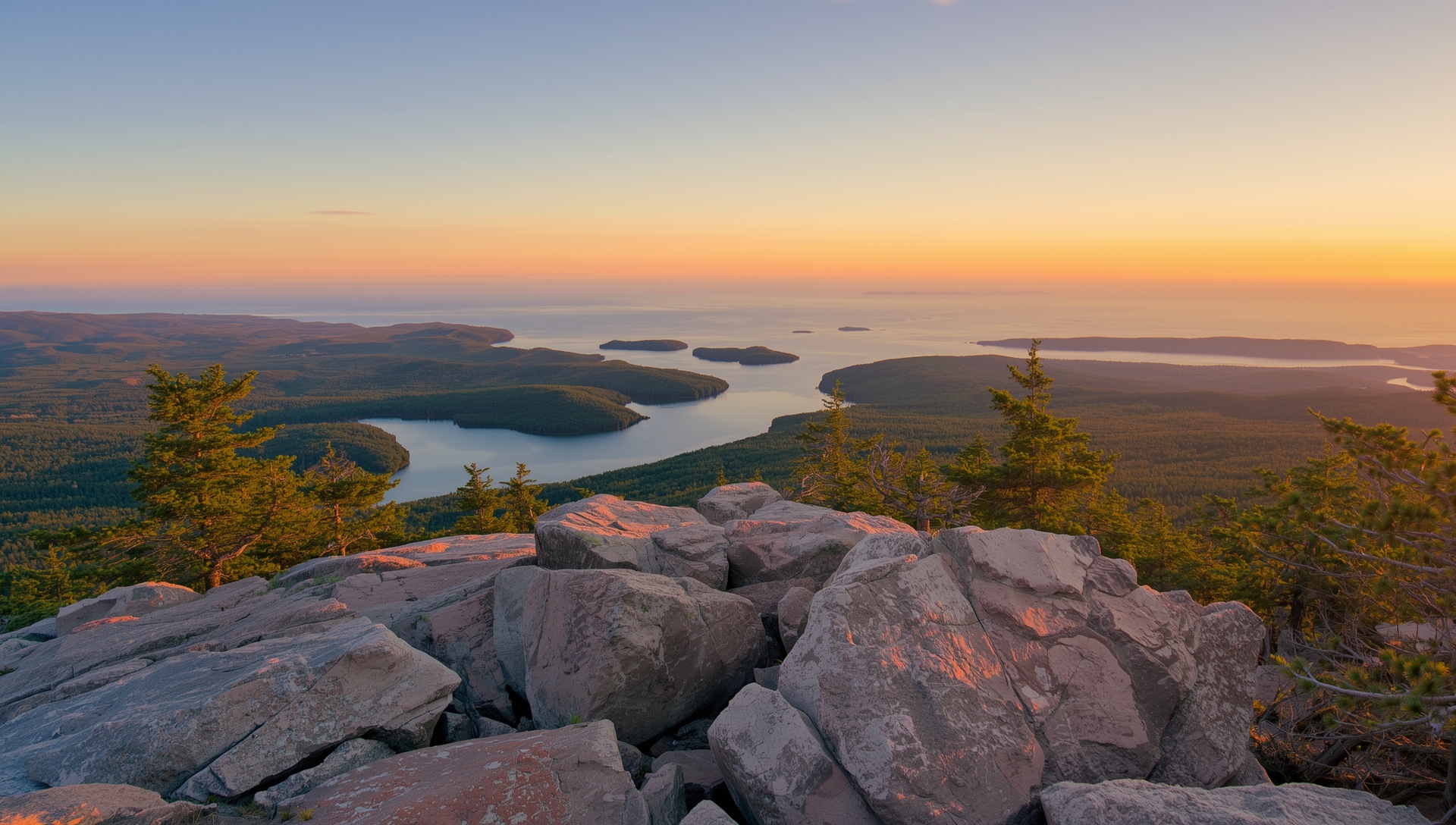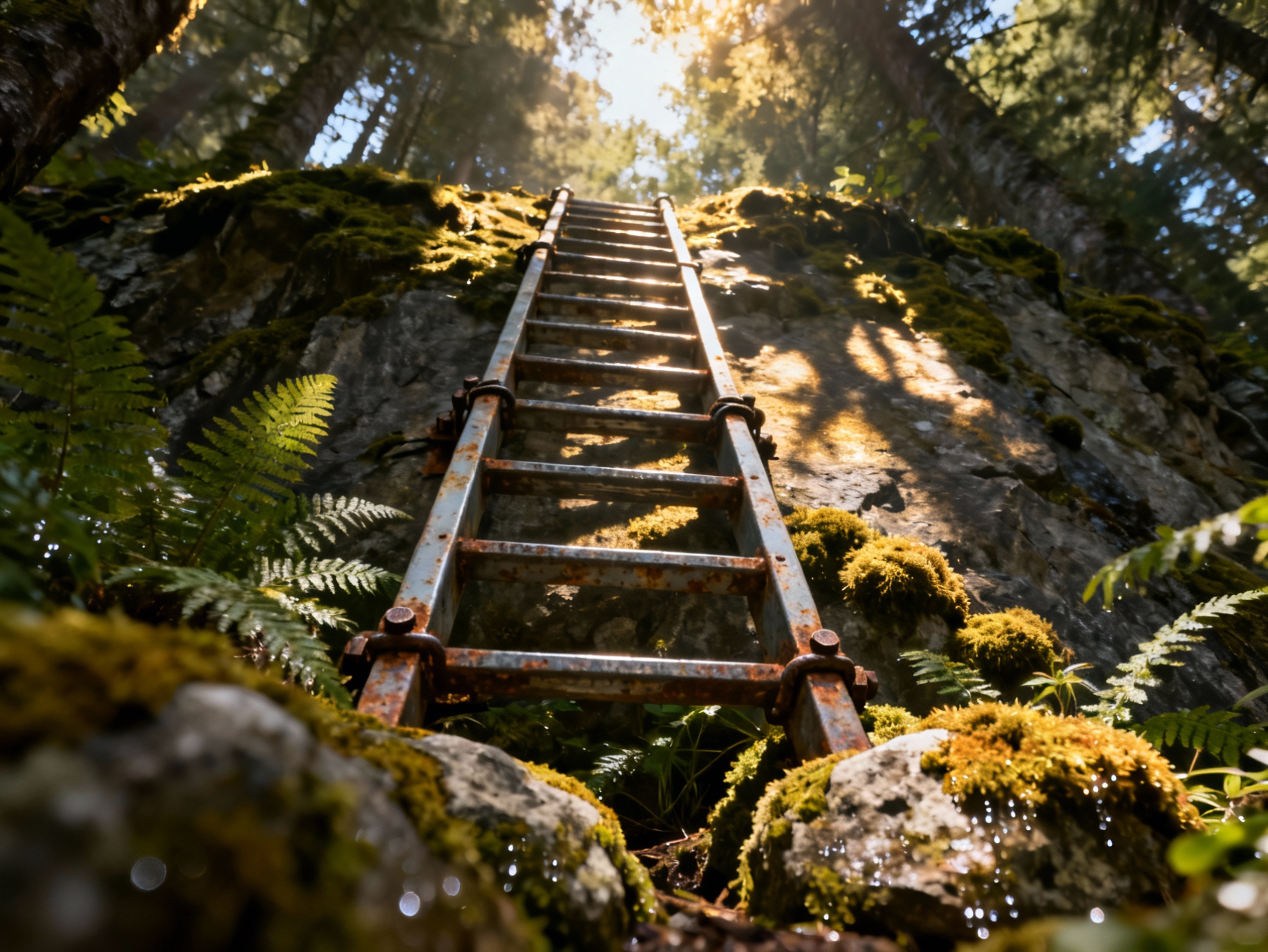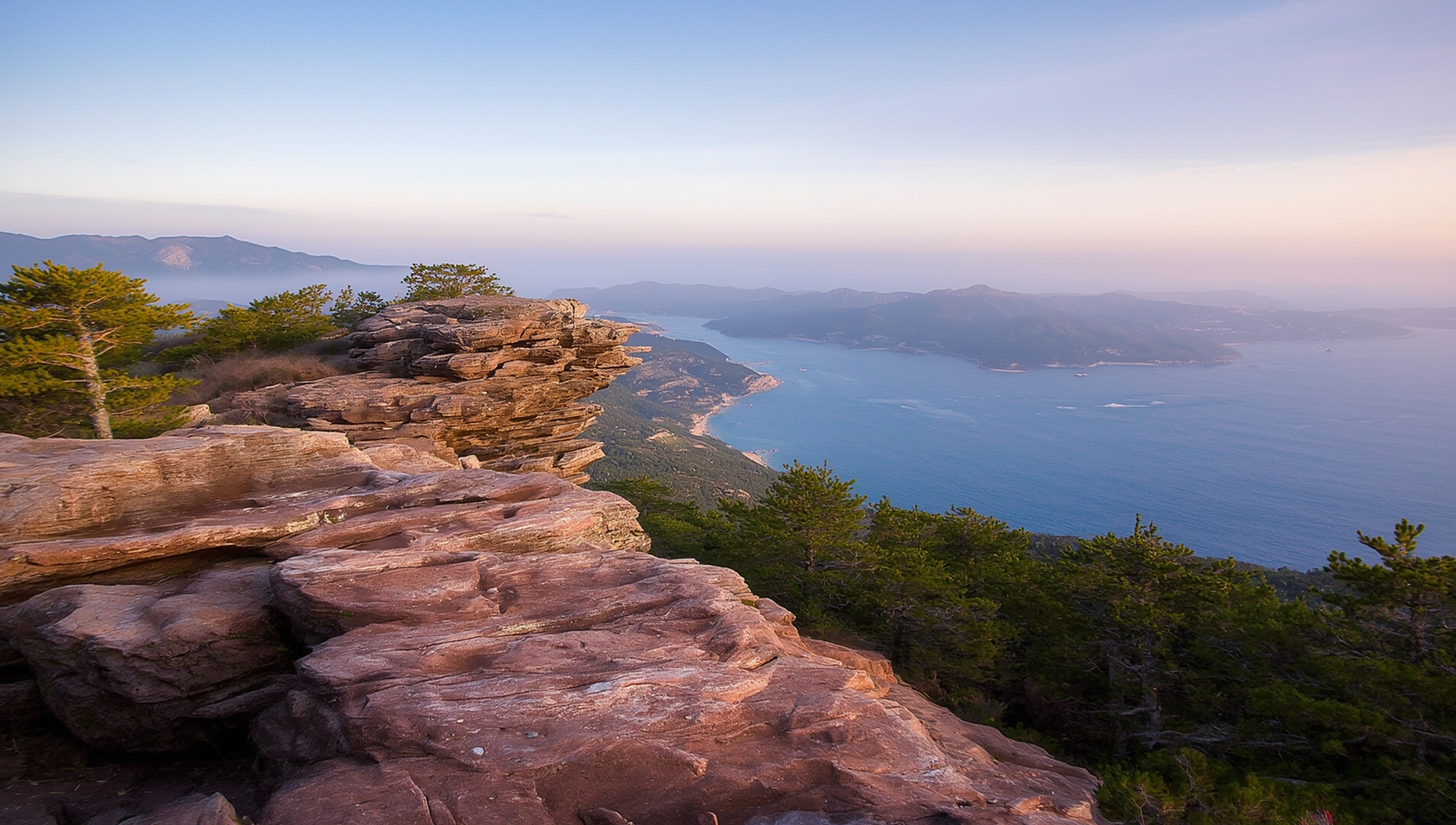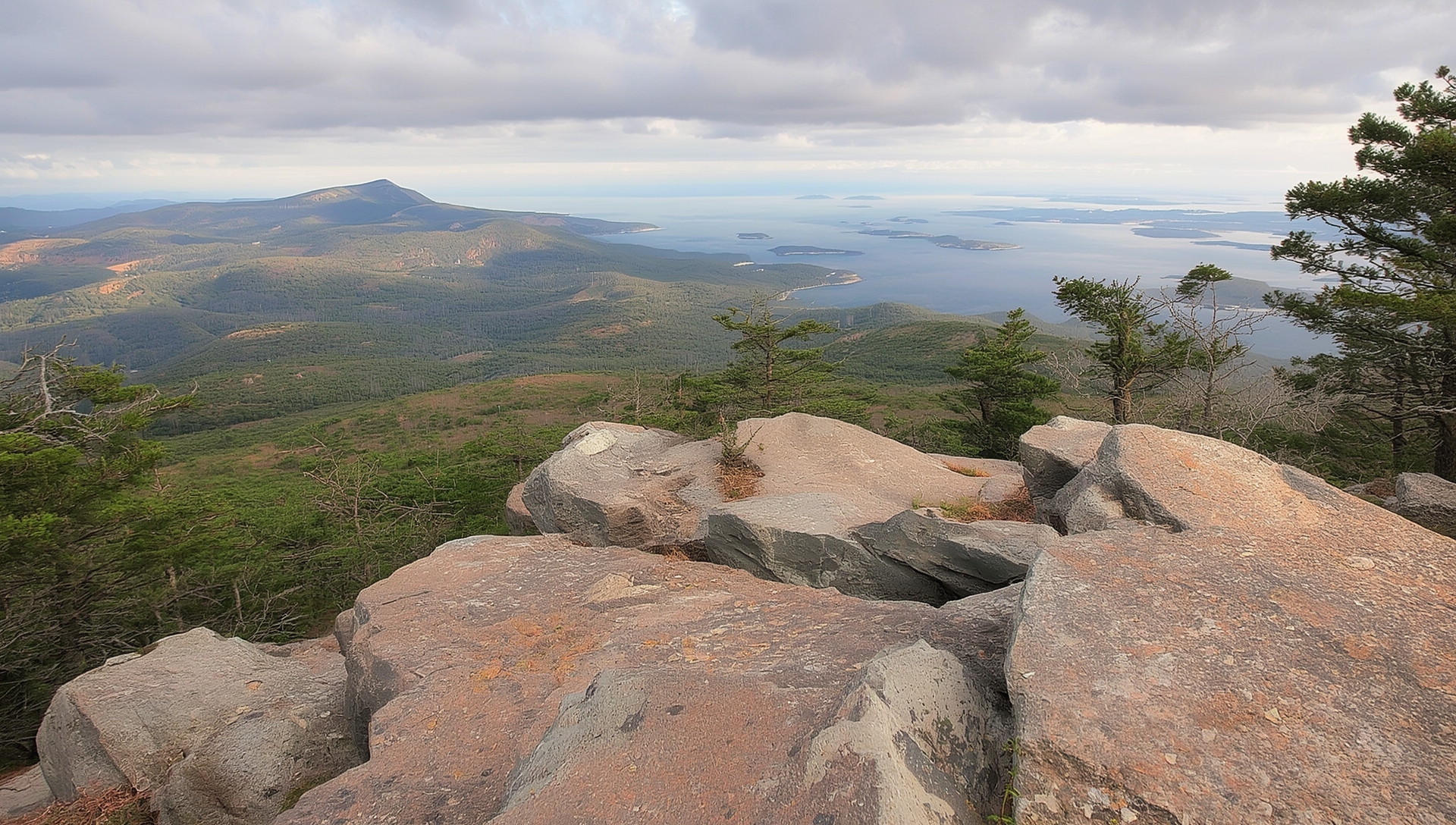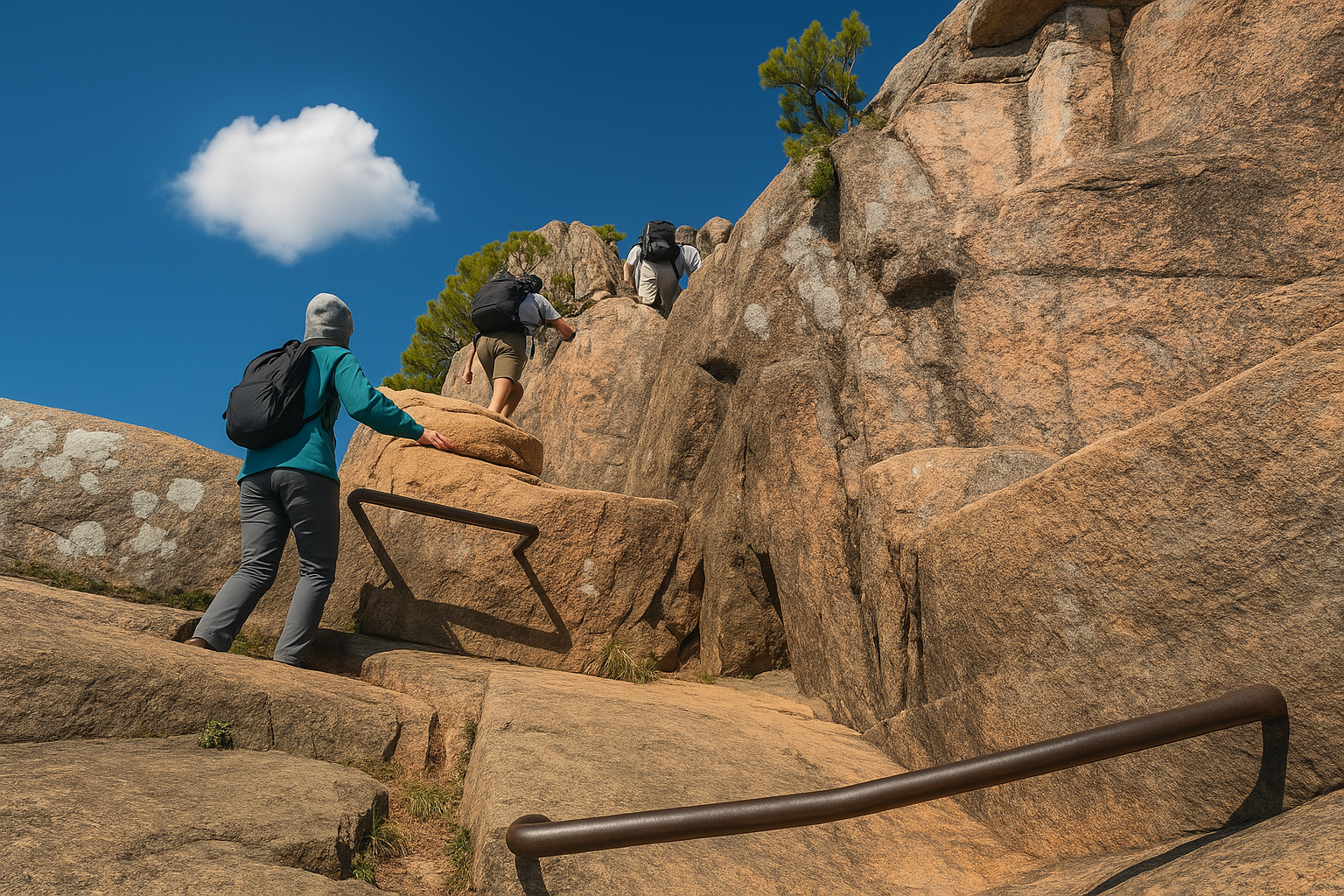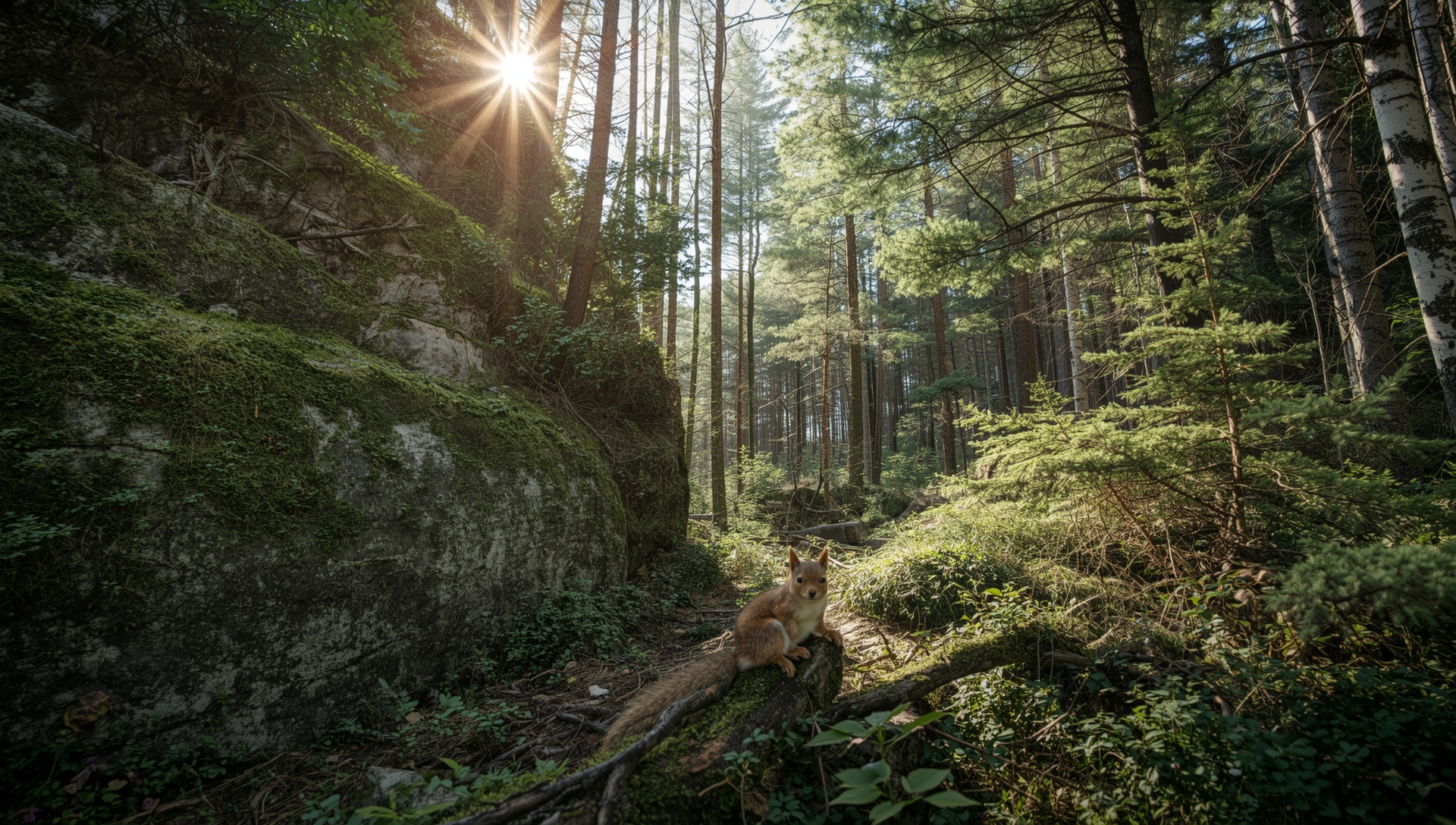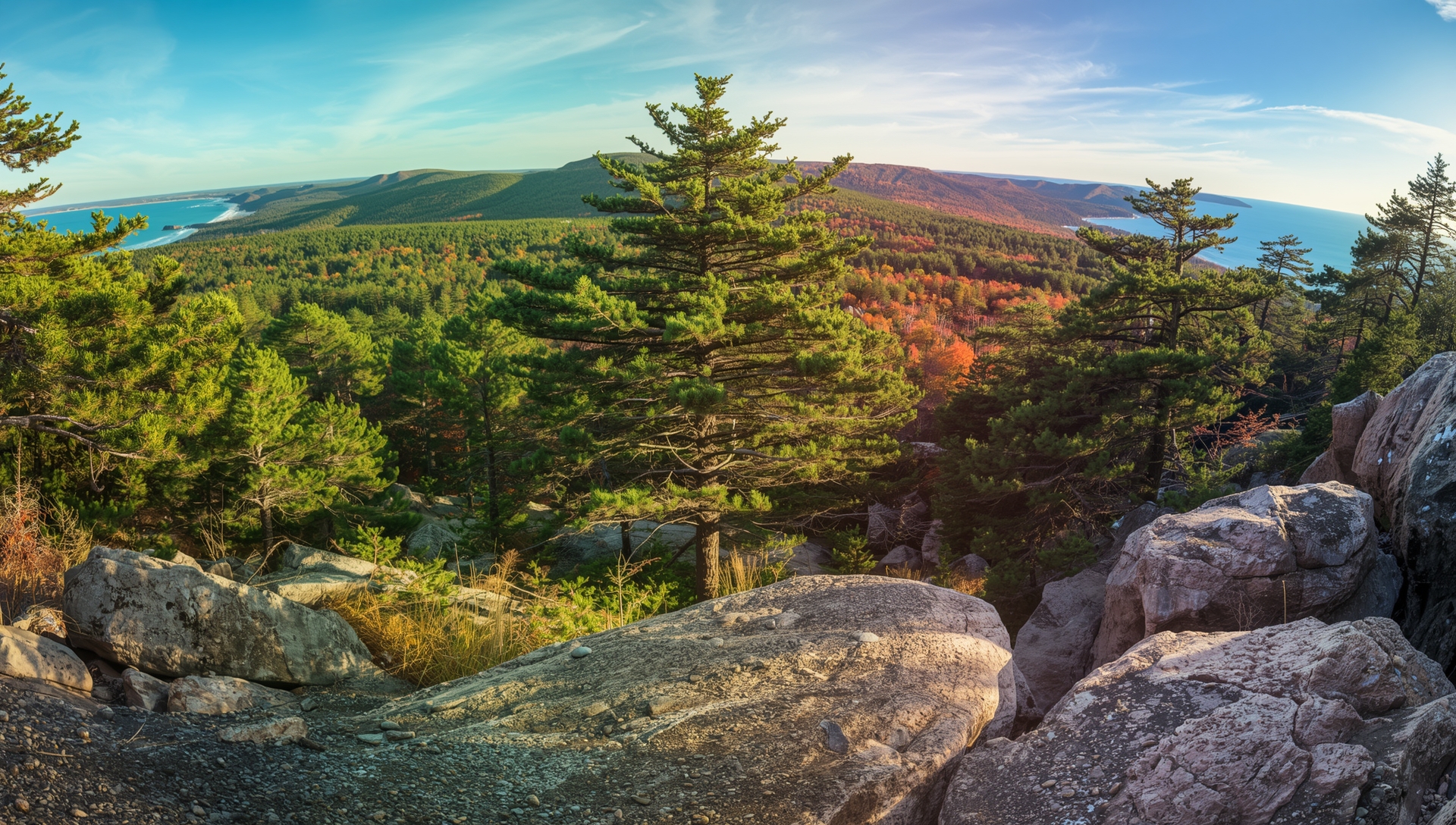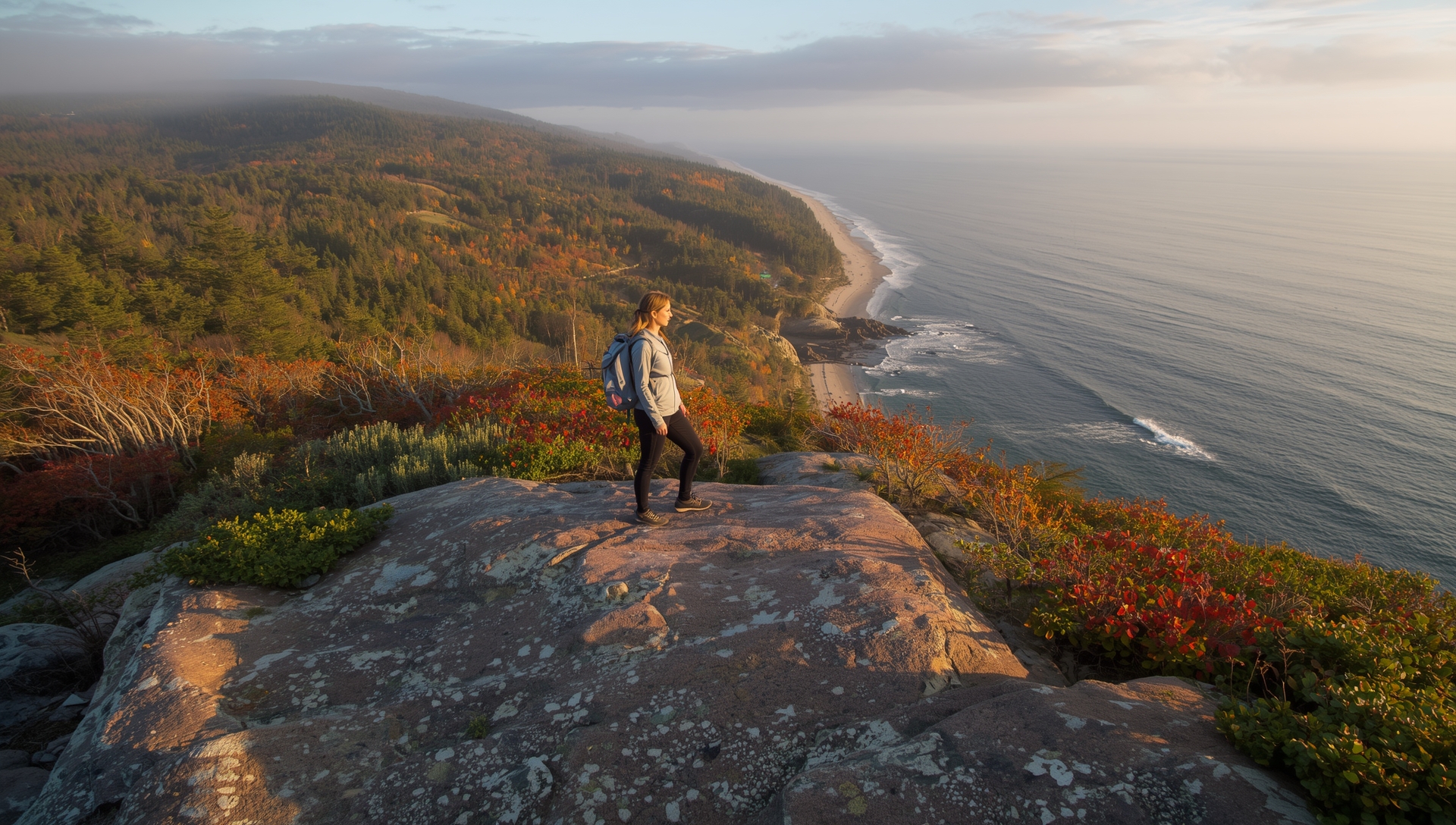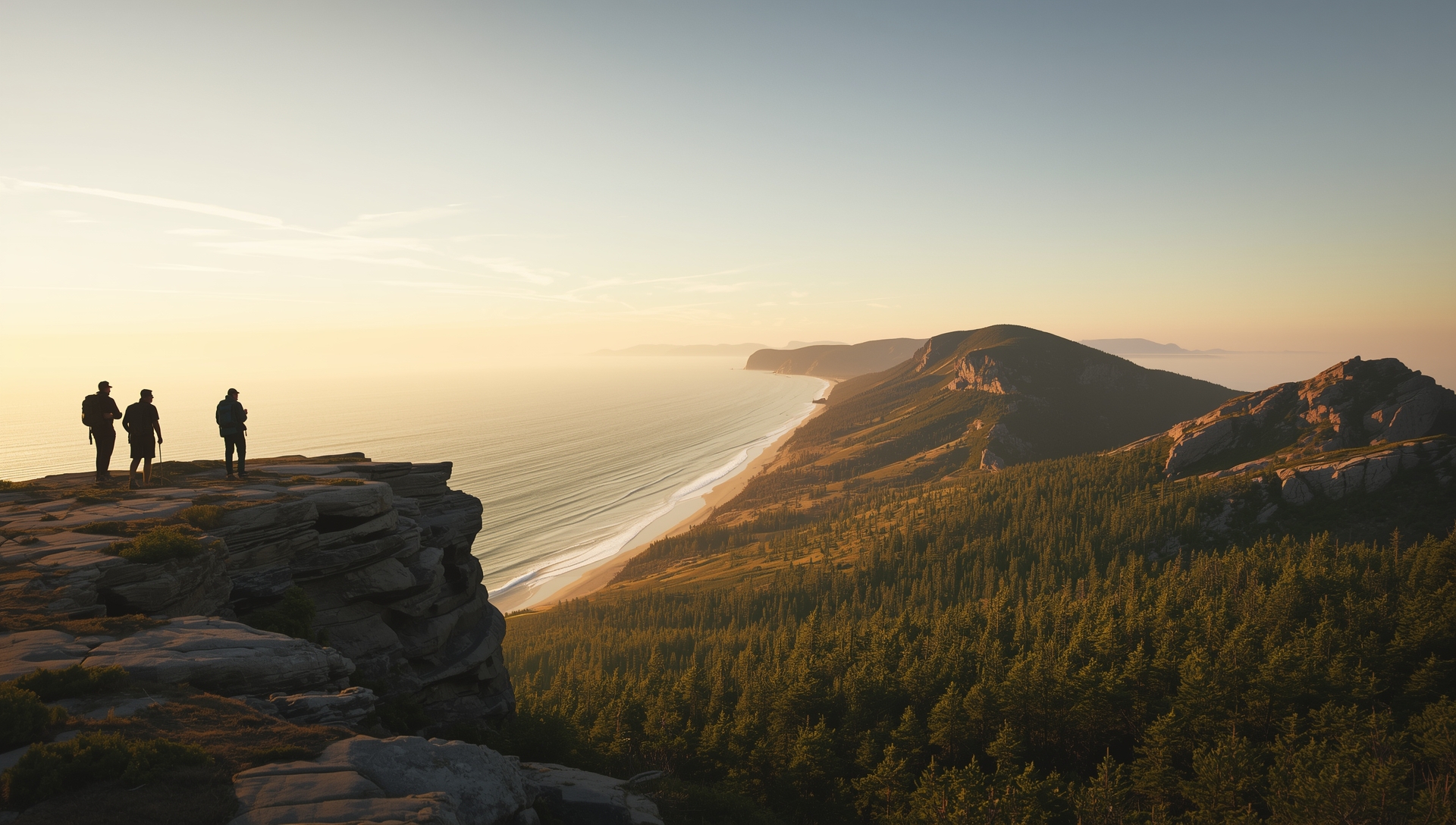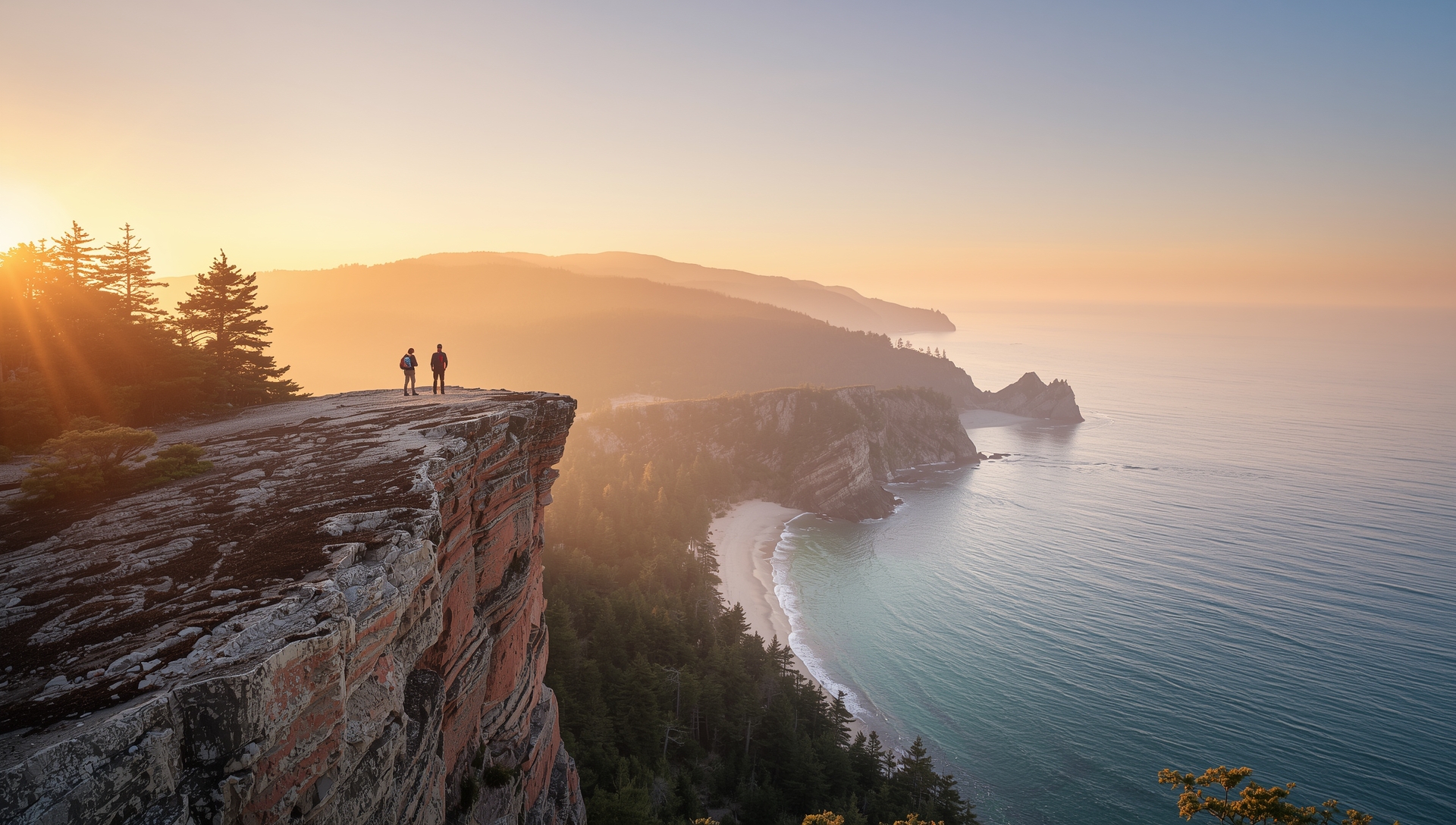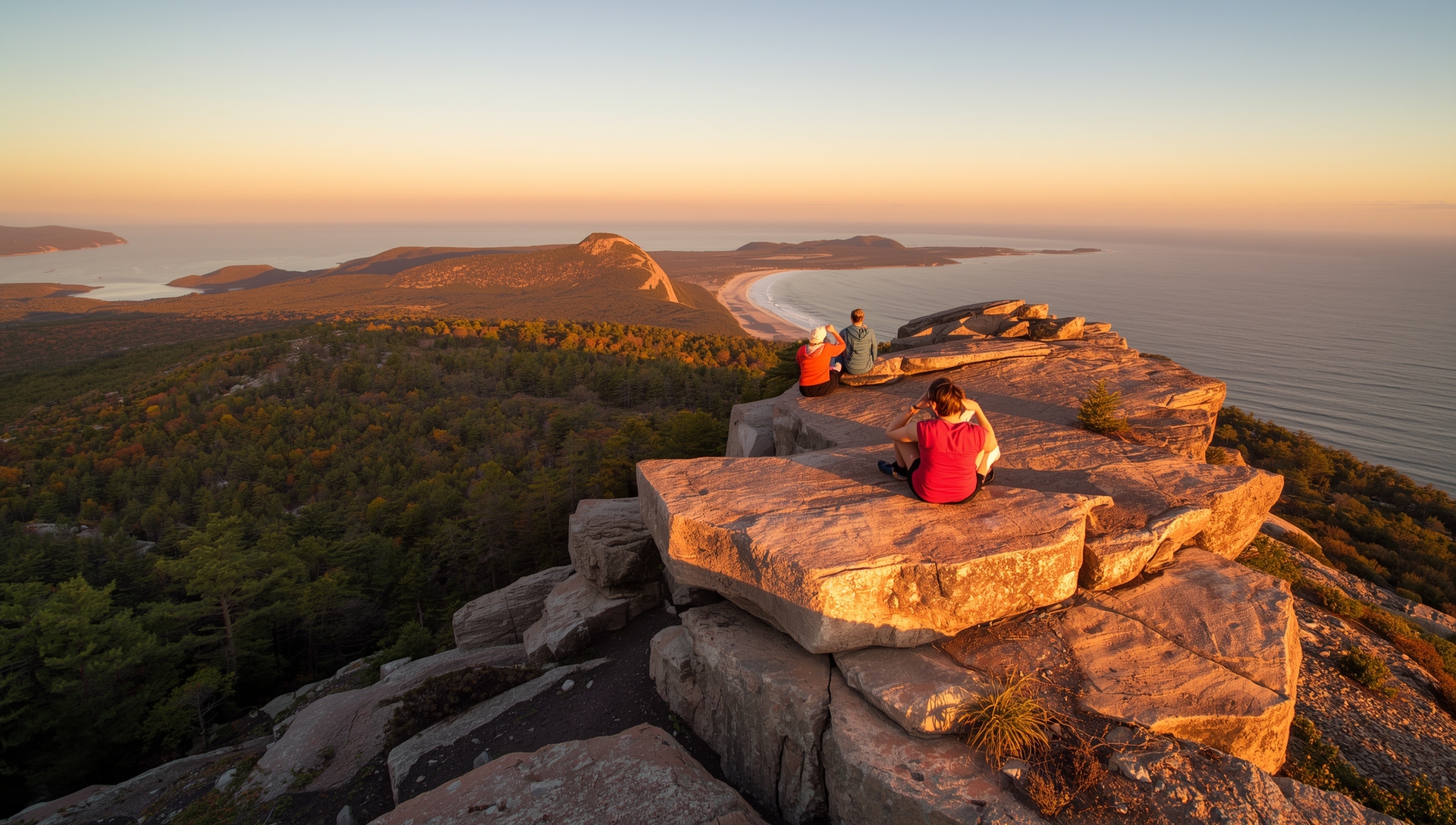Home › Acadia National Park › Trails in Acadia National Park › Beehive Trail Acadia
Beehive Trail Acadia National Park
A Serene Start Around Beehive Trail Acadia
Beehive Trail in Acadia National Park is one of the park’s most talked-about hikes — short, steep, and spectacular. From the first steps near Sand Beach, the trail rises quickly over exposed granite ledges, winding through spruce and pine before the famous iron rungs appear. Known locally as the Beehive Acadia climb, this 1.4-mile loop delivers some of the best ocean panoramas in all of Maine. The combination of challenge and beauty has made the Beehive Trail Acadia a must-do for adventurous hikers visiting the park.
As you ascend, every rung and ledge opens up a broader view of Frenchman Bay, Sand Beach, and the rugged coastline that defines Acadia National Park. Despite its popularity, the trail often feels personal and peaceful — the granite absorbs sound, and the wind off the Atlantic brings the scent of pine and salt. The climb is demanding but exhilarating, offering a deep sense of accomplishment at the summit. Many hikers link the Beehive Loop Trail Acadia with the Bowl Trail Acadia to create a perfect circuit that balances adrenaline with calm.
Whether you come for the thrill of the Beehive Hike Acadia, to capture photographs of the cliffs in autumn light, or simply to experience one of Acadia’s signature routes, this trail captures the park’s essence — wild, vertical, and unforgettable. With careful footing and respect for its exposure, the Acadia Beehive Trail rewards every step with sweeping scenery and the satisfaction of standing high above the Maine coast.
• Location: Mount Desert Island, near Sand Beach Trailhead
• Length: 1.4 miles (2.3 km) loop
• Elevation Gain: 520 ft (158 m)
• Difficulty: Hard – iron rungs and exposed ledges
• Trail Type: Loop via Beehive and Bowl Trail
• Best Season: Late Spring through Fall for clear views and safe conditions
• Highlights: Iron-rung climb, Frenchman Bay overlook, Beehive Mountain summit, Sand Beach vista
• Related Keywords: Beehive Trail Acadia National Park, Beehive Loop Trail Acadia, Beehive Hike Acadia, Beehive Mountain Acadia, Acadia Beehive Trail, Beehive Trail Acadia Map, Beehive Trail Acadia Photos
Trail Experience: Walking the Beehive Trail Loop
The Beehive Trail Acadia National Park is one of those hikes that feels like an adventure from the moment your boots hit the first stone. It begins innocently enough on the forest floor near Sand Beach, where the trail splits from the Bowl Trail beneath a canopy of spruce and birch. The air smells of pine needles and ocean spray, and the distant crash of waves echoes through the trees. Within minutes, though, the ground begins to tilt upward, the trees thin, and the granite ledges appear — a clear sign that this is no ordinary walk in the woods.
The Beehive Hike Acadia is best known for its iron rungs — a thrilling series of handholds and footholds drilled into the pink granite that help hikers climb the steep face of the famous Beehive Mountain. Each rung offers a mix of excitement and focus. The exposure is real, but it’s balanced by the solid footing and the rhythm of the ascent. Many hikers pause to look back, where the view of Sand Beach grows smaller and the blue sweep of Frenchman Bay begins to dominate the horizon. The Beehive Trail Acadia National Park demands attention, yet rewards it with a sense of complete immersion in Acadia’s raw landscape.
As you climb higher, the ledges open wide and the coastal panorama stretches out — evergreen ridges, curved bays, and small islands scattered like stones in a painter’s palette. The granite beneath your hands feels warm in the sun, its pink and gray tones glowing against the deep blue of the Atlantic. The climb is steady but never dull. Each turn reveals a new vantage point or a short section of open cliff where you can stop to breathe, listen to the gulls, and take in the vastness of the scene. It’s here that many realize why the Beehive Acadia has become one of the park’s signature hikes — it’s not just the difficulty, it’s the intimacy of being suspended between mountain and sea.
Once you reach the top, the summit flattens into a series of rounded slabs surrounded by low blueberry bushes and the scent of salt carried on the wind. The view northward takes in Great Head and the shimmering water of Frenchman Bay, while to the west you can spot the glacial bowl that gives the nearby Bowl Trail its name. On quiet mornings, the surface of the pond reflects the sky in mirror-like stillness — a perfect counterpoint to the rugged climb that brought you there. Most hikers choose to descend via the Bowl Trail, creating a gentle loop that winds through shady forest and moss-covered stone before returning to the Sand Beach parking area.
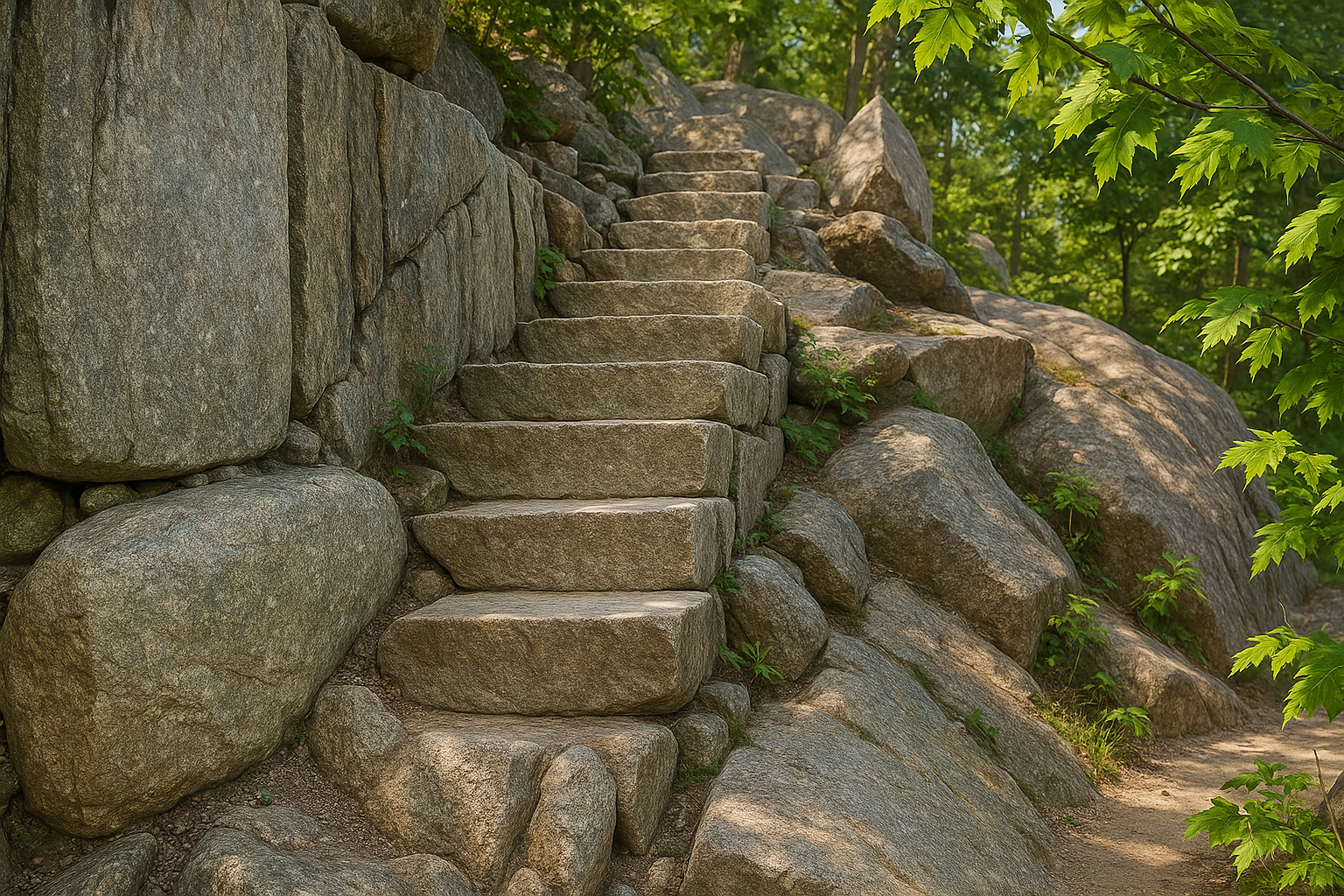
Every stage of the Beehive Loop Trail Acadia tells a different part of the park’s story — from coastal forest to exposed cliff, from heart-pounding ascent to tranquil descent through woodland. It’s a hike that combines excitement with elegance, one that stays in your memory long after your legs have rested. The Beehive Trail isn’t just about the iron rungs or the view from the top — it’s about feeling the rhythm of Acadia itself: its balance of strength and serenity, challenge and beauty, risk and reward.
• The Beehive Trail begins near Sand Beach on Mount Desert Island and quickly ascends steep granite ledges using a series of iron rungs.
• It’s a 1.4-mile (2.3-km) loop with about 520 feet (158 m) of elevation gain — short but steep and exposed.
• Best tackled in dry conditions; avoid on rainy or windy days due to slippery ledges.
• The route connects with the Bowl Trail for a scenic return through forest and pond views.
• Expect spectacular overlooks of Frenchman Bay, Sand Beach, and the Atlantic coast.
• Early mornings or late afternoons provide softer light, fewer crowds, and calm ocean air.
• Not suitable for those with severe fear of heights — but ideal for confident, careful hikers seeking one of Acadia’s most thrilling experiences.
• Related Keywords: Beehive Trail Acadia, Beehive Loop Trail Acadia, Beehive Hike Acadia, Beehive Trail Acadia National Park, Acadia Beehive Trail
Trail Facts: Beehive Trail Acadia
The Beehive Trail Acadia may be short in distance, but it’s one of the park’s most memorable climbs. Located on Mount Desert Island just across from Sand Beach, this 1.4-mile loop is both a rite of passage and a test of nerve for visitors eager to experience the best of Acadia National Park in a compact, adrenaline-filled package. The name “Beehive” comes from the mountain’s shape — a smooth, rounded dome of pink granite that rises 520 feet above the Atlantic, resembling an old-fashioned straw beehive.
From the trailhead, hikers step immediately into Acadia’s unique mix of coastal forest and bare rock. The first part of the trail meanders through pines, firs, and spruces, hinting at what’s to come as the terrain quickly begins to steepen. Once the iron rungs appear, the true adventure begins. Unlike most hikes in the park, the Beehive Trail Acadia National Park uses a network of hand-forged iron bars, railings, and ledges built directly into the rock face. These allow hikers to climb vertically while hugging the exposed cliff, all with breathtaking views unfolding behind them.
The route is compact but demanding. Over the course of just over a mile, hikers ascend 520 feet — most of it within the first half-mile. The Beehive Loop Trail Acadia connects briefly with the Bowl Trail, which circles a peaceful mountain pond. Many hikers use that section for a gentle descent, completing the loop and returning to the Sand Beach parking area. The combination of steep ascent, ocean views, and a quiet forested return makes this trail one of Acadia’s most complete micro-adventures.
Safety is paramount here. Though thousands of people complete the climb each year, this trail is not suitable for everyone. The ledges are narrow, and the exposure is real — a slip in the wrong place could have serious consequences. The Beehive Hike Acadia should only be attempted in dry weather and by those comfortable with heights. For that reason, children and dogs are not recommended on the rungs section. Those who prefer a less vertical experience can reach the summit via the Bowl Trail from the opposite direction, avoiding the steep cliffs entirely.
At the top, the reward is extraordinary. The summit of the Acadia Beehive Trail opens to panoramic views of Sand Beach Acadia, Great Head, and Frenchman Bay, with the distant Schoodic Peninsula visible on clear days. The air smells of spruce and sea salt, and the granite warms underfoot. Even seasoned hikers pause here — not just to catch their breath, but to take in the sweep of land and water that defines Acadia’s beauty. For many, this moment is the highlight of their visit: the feeling of standing on the edge of Maine’s rugged coast, suspended between sky and sea.
• Trail Length: 1.4 miles (2.3 km) loop
• Elevation Gain: 520 feet (158 m)
• Location: Mount Desert Island, opposite Sand Beach
• Trailhead: Park Loop Road near Sand Beach parking area
• Difficulty: Hard – steep iron rungs and narrow ledges
• Best Time: Late spring to early fall for dry rock and clear views
• Summit View: Sand Beach, Great Head, Frenchman Bay, and the Schoodic Peninsula
• Route Option: Descend via Bowl Trail for an easier return
• Related Keywords: Beehive Trail Acadia, Beehive Trail Acadia National Park, Beehive Loop Trail Acadia, Beehive Hike Acadia, Acadia Beehive Trail
Trail Highlights & Nearby Spots
From the summit of the Beehive Trail Acadia National Park, the landscape unfolds in a way that feels both vast and intimate. You’re standing on a rounded crown of pink granite, where wind and sea meet in a dance that has shaped Mount Desert Island for millennia. Below, Sand Beach glimmers like a crescent of gold — a perfect arc of sand framed by evergreens and cliffs. Beyond it, the deep blue of Frenchman Bay stretches to the horizon, dotted with small islands that seem to float in the haze. It’s here that the Beehive Hike Acadia earns its reputation, not only for the physical challenge of its iron-rung ascent but for the reward it offers at the top — a sweeping, unforgettable perspective of Acadia’s coastline.
Every part of the Beehive Loop Trail Acadia feels carefully composed by nature. The climb is intense and direct, but it’s followed by the soothing calm of the descent through forest and the shimmering quiet of The Bowl — a hidden glacial pond tucked between the Beehive Mountain and Champlain Mountain Acadia National Park. On still days, the water mirrors the sky so perfectly that you can see the passing clouds glide across its surface. Loons sometimes call from the far side, their haunting echo carried on the breeze. It’s the ideal place to stop, breathe, and feel the contrast between the exposed cliffs above and the serenity below. This balance between thrill and peace is one of the Beehive’s greatest strengths — it’s not just a climb, it’s a complete sensory experience of Acadia National Park.
From the summit, your eyes naturally wander toward the east, where Great Head Trail traces a bold line along the coastline. The headland juts into the Atlantic, its pink cliffs washed in light during sunrise and sea mist by afternoon. Many hikers extend their Beehive adventure by exploring this neighboring trail, especially since it starts at Sand Beach, just across from the Beehive trailhead. Great Head rewards you with dramatic ocean views, wildflowers clinging to rock shelves, and tide pools teeming with life — crabs, sea stars, and barnacles among them.
Turn west, and you’ll spot the rounded form of Gorham Mountain, another of Acadia’s classic hikes. The Gorham route connects easily with the Bowl Trail, creating a longer but moderate circuit that combines ridge views, forest walks, and sweeping glimpses of the coastline. This network of trails makes the Beehive area one of the park’s most compact yet rewarding hiking zones. Within a few miles, you can experience everything that makes Acadia so special — iron rungs, granite peaks, mirror-still ponds, and Atlantic breezes.
Each nearby destination also shifts with the seasons. Spring brings damp pine scents and soft mist. Summer turns the granite warm underfoot, and the ocean breeze offers gentle relief after the climb. The Fall ushers in a transformation of everything into a painter’s palette of orange and crimson against the blue bay. Even during an Winter, when the light is sharp and the crowds have vanished, the Beehive and its surroundings retain their quiet grandeur. Few trails in the United States pack so much contrast and beauty into such a small space. The Beehive Trail Acadia National Park area is a masterpiece of nature’s design — compact, powerful, and endlessly photogenic.
• The Bowl: A tranquil glacial pond hidden between Beehive and Champlain Mountain, ideal for rest and reflection
• Sand Beach: Iconic golden shoreline directly below the Beehive summit, perfect for post-hike relaxation
• Great Head Trail: Coastal path with dramatic cliffs, tide pools, and spectacular sunrise views
• Gorham Mountain Trail: Connects with Beehive and Bowl for a scenic loop combining cliffs, forest, and ocean
• Ocean Path: Family-friendly coastal route from Sand Beach to Thunder Hole and Otter Cliffs
• Best Photo Times: Early morning for soft light on granite; late afternoon for golden hues over Frenchman Bay
• Related Keywords: Beehive Trail Acadia, Beehive Loop Trail Acadia, Beehive Hike Acadia, Sand Beach Acadia, Great Head Trail, Acadia Beehive Trail
Nature & Wildlife along the Beehive Trail
The Beehive Trail Acadia National Park isn’t just a climb — it’s a living gallery of coastal ecology. Every ledge, crack, and patch of soil along the route tells a story about how life survives in one of the most exposed corners of Mount Desert Island. Though the ascent feels rugged and barren at times, the granite face is alive with detail. Tiny tufts of reindeer lichen, mats of low blueberry shrubs, and patches of green moss cling to the rock, thriving where only a handful of soil grains collect. These hardy plants are part of the granite ridge ecosystem that makes Acadia so distinctive — small but perfectly adapted to the mix of salt, sun, and wind.
As you climb, the scent of pine becomes stronger. Red spruce and pitch pine — Acadia’s signature coastal conifers — anchor themselves in cracks between the rocks, their roots twisting through granite like cables. Near the base, oak and birch dominate, forming a shaded woodland that shelters warblers and chipmunks. Higher up, the vegetation thins and the light opens up, creating panoramic spaces where the Atlantic breeze moves freely. These pockets of forest and open ledge are home to the park’s iconic wildlife: white-tailed deer browsing at dawn, red squirrels chattering from tree limbs, and peregrine falcons gliding along the cliffs.
The Beehive’s cliffs are particularly important for Acadia’s peregrine falcon restoration program. These birds of prey, once nearly wiped out by pesticide use, now return each spring to nest on the ledges above Sand Beach. During nesting season, rangers sometimes close small portions of the Beehive Trail to protect the chicks — a small reminder that Beehive Mountain belongs to more than just hikers. If you’re lucky, you may hear their high, sharp cries echoing through the valley or catch a glimpse of a falcon diving at incredible speed.
n the sheltered corners of the trail — especially around The Bowl and its wooded descent — the ecosystem changes completely. Moisture gathers here, supporting ferns, wildflowers, and mushrooms that would never survive on the sun-baked cliffs. Salamanders hide under logs, while dragonflies hover above the pond’s surface in summer. Even the granite itself provides microhabitats, storing warmth during the day and releasing it slowly through the evening, helping certain mosses and insects endure Acadia’s coastal chill.
Every few steps along the Beehive Trail Acadia National Park reveal a new rhythm of life — a blend of coastal forest and mountain ecology that mirrors the broader beauty of Acadia. Whether it’s the flash of a falcon’s wings or the quiet rustle of pine needles, the trail’s wildlife is woven into the granite itself, a reminder that this climb is more than a view — it’s part of a living, breathing landscape.
• Peregrine Falcons: Nesting on Beehive’s cliffs each spring — look for aerial dives near Sand Beach
• Red Squirrels & Chipmunks: Common in forested lower sections of the trail
• White-Tailed Deer: Often grazing near the Bowl in the early morning
• Dragonflies & Frogs: Active around The Bowl and nearby wetlands in summer
• Lichen & Moss: Hardy species clinging to granite ledges and cracks
• Seasonal Note: Trail closures may occur in spring to protect falcon nesting zones
• Related Keywords: Beehive Trail Acadia, Beehive Trail Acadia National Park, Beehive Hike Acadia, Acadia Beehive Trail, Beehive Loop Trail Acadia
Seasons on the Beehive Trail
Every season reshapes the Beehive Trail Acadia National Park into something new — the same climb, yet a completely different experience. The trail’s mix of ocean air, mountain granite, and forest life means that no two months ever look or feel the same. Whether you’re tackling the Beehive Loop Trail Acadia in the warmth of summer or standing on the summit under a crisp fall sky, each season reveals a fresh side of Acadia’s character.
Acadia in Spring sees the Beehive wake up. Snowmelt trickles down the granite cracks, filling the mossy channels that line the lower forest near The Bowl Trail. Wildflowers like bunchberry and violet appear briefly before the canopy thickens, and the red squirrels become bold again after the quiet of winter. The Atlantic winds are cool but gentle, and the smell of pine and salt mixes in the air. For many locals, spring is the most peaceful time to hike the Acadia Beehive Trail — before summer crowds arrive, when the cliffs are silent except for gulls circling overhead.
Acadia National Park in Summer is when the Beehive Trail Acadia shows its most iconic face. The granite warms underfoot, and sunlight flickers between the coastal pines as you climb the iron rungs. The sea breeze coming off Frenchman Bay offers relief after each scramble, carrying the faint sound of waves breaking along Sand Beach Acadia below. The view from the top is spectacular — a mosaic of blue water, forest, and rock stretching as far as Mount Desert Island allows. This is also the season when peregrine falcons are active, so visitors are reminded to respect seasonal closures that protect nesting sites. Despite the crowds, summer on the Beehive feels vibrant and alive — the pulse of Acadia National Park concentrated into one short, thrilling loop.
Acadia in the Fall sees the trail become a painter’s dream. The oaks and birches blaze gold and crimson, contrasting beautifully with the evergreen pines and the gray-pink granite ledges. The air turns crisp, and the angle of sunlight softens the entire landscape. From the Beehive summit, Sand Beach glows under a canopy of color, and the Great Head Trail across the bay looks like it’s on fire with fall foliage. It’s an ideal time for photographers, with fewer people and long, golden afternoons. Every turn on the Beehive Hike Acadia offers another view — the reflection of red leaves in The Bowl, or the quiet of the forest floor as leaves rustle underfoot.
An Acadia National Park Winter, though less traveled, is the Beehive’s secret season. While the main trail is closed for safety during icy periods, the surrounding woods and nearby Bowl Trail offer serene walks through snow-dusted forest. The granite cliffs gleam in pale light, and Sand Beach looks almost silver from a distance. The park feels silent, timeless — as if nature is holding its breath. Those who visit during this time understand that the Beehive’s beauty isn’t only in its challenge, but also in its stillness.
Across every season, the Beehive Trail Acadia remains one of the most rewarding short hikes in the park. It’s the rhythm of the year — spring’s renewal, summer’s energy, autumn’s fire, and winter’s calm — carved into stone and framed by sea and sky.
• Spring: Cool breezes, wildflowers, and quiet forest trails before the crowds
• Summer: Warm granite, sea-salt air, and vibrant wildlife on the Beehive Loop Trail Acadia
• Autumn: Fiery foliage views over Sand Beach and Great Head Trail
• Winter: Peaceful forest walks near The Bowl and snow-kissed granite cliffs
• Best Photography: Sunrise in summer or golden-hour light in fall
• Related Keywords: Beehive Trail Acadia, Beehive Loop Trail Acadia, Beehive Trail Acadia National Park, Acadia Beehive Trail, Beehive Hike Acadia, Sand Beach Acadia, The Bowl Trail
Planning Your Visit: Beehive Trail Acadia
Hiking the Beehive Trail Acadia National Park is a highlight for many visitors to Mount Desert Island — but a little planning can make all the difference between a thrilling climb and a stressful one. Because this trail’s popularity matches its fame, timing, parking, and weather all shape the experience. The Beehive Trail sits just off Park Loop Road, directly across from Sand Beach, making it one of the easiest major trailheads to reach in Acadia. The short approach path from the Sand Beach parking area is clearly marked, leading hikers quickly into the forest before the climb begins.
The Beehive Trail itself is a 1.4-mile loop that takes most visitors between one and two hours to complete, depending on comfort with heights and photo stops. The ascent features iron rungs, narrow ledges, and open granite faces, so it’s best suited for confident hikers without a fear of heights. Many choose to ascend the Beehive and descend via the Bowl Trail, which loops behind Beehive Mountain, past a quiet pond surrounded by pines. This descent avoids the steepest sections while still offering beautiful views. The combination creates a loop that’s exciting yet manageable, offering the perfect balance of challenge and scenery.
Because the Beehive Trail Acadia can become crowded, aim to start early in the morning — ideally before 8 a.m. — or later in the afternoon after the tour buses have departed. Parking near Sand Beach Acadia fills quickly, especially in summer, and rangers often redirect cars to the nearby Gorham Mountain lot or along Otter Cliff Road when capacity is reached. Visitors staying in Bar Harbor can also take the Island Explorer shuttle, which stops at Sand Beach and removes the parking stress entirely.
Weather plays a major role on the Beehive. Wet granite can become slick, and strong winds near the summit can make exposed sections feel precarious. Always check the park’s daily weather and trail closure updates before setting out — particularly in early spring and late autumn when freeze–thaw cycles can affect conditions. Footwear with firm grip and a small daypack are all you need; hiking poles aren’t recommended here due to the climbing sections.
Those hoping to photograph the Beehive Trail Acadia at its best will find golden light before 9 a.m. or near sunset, when the Atlantic Ocean below Sand Beach glows deep blue and the granite catches pink and amber tones. In autumn, the surrounding forests erupt in reds and golds, making this one of the most scenic overlooks in Acadia National Park. For a longer adventure, many hikers continue south on the Ocean Path Trail, connecting the Beehive with Thunder Hole, Otter Cliffs, and Monument Cove — a stunning coastal stretch that rivals the Beehive’s views at sea level.
Whether you’re an early riser chasing sunrise over the water or an afternoon explorer looking for an iconic Acadia climb, the Beehive Trail delivers a memory that lingers long after your descent. With mindful preparation and respect for the conditions, it’s the kind of hike that defines a trip to Acadia: wild, breathtaking, and unforgettable.
• Trailhead: Across from Sand Beach Acadia on Park Loop Road
• Distance: 1.4 miles round-trip (loop via Bowl Trail optional)
• Elevation Gain: ~520 ft
• Duration: 1–2 hours depending on pace
• Difficulty: Moderate to strenuous due to exposed ledges and iron rungs
• Best Time: Sunrise and sunset for soft light and fewer crowds
• Parking: Sand Beach lot or Island Explorer shuttle
• Nearby Highlights: Thunder Hole, Ocean Path, The Bowl, Otter Cliffs
Remember — Beehive Trail Acadia rewards preparation. Early starts, sturdy shoes, and respect for park safety rules ensure an unforgettable and safe climb above Maine’s stunning coastline.
Reflect & Explore More
Standing atop the Beehive Trail Acadia, it’s hard not to feel both awe and accomplishment. In less than two miles, you’ve climbed through forests, scaled iron rungs, and emerged onto one of the most breathtaking vantage points in all of Acadia National Park. Below, the soft arc of Sand Beach curves like a brushstroke against the Atlantic, while pine-covered ridges ripple toward the horizon. The sounds of surf, wind, and the distant call of gulls seem to blend into one — a reminder that this park’s beauty is as much about its rhythm as its views.
For many hikers, the Beehive Trail isn’t just a climb — it’s a defining Acadia experience. It condenses everything that makes this national park extraordinary: pink granite cliffs, ocean panoramas, crisp coastal air, and a sense of challenge that rewards both courage and curiosity. As the morning light shifts and the crowds begin to arrive, the summit feels alive with shared wonder — hikers trading smiles, photographers capturing the glow, and families celebrating the climb together.
When you descend via The Bowl Trail, pause for a moment beside the still water. This quiet pond, nestled between ridges, reflects the sky like glass and offers the perfect counterpoint to the adrenaline of the ascent. It’s here that the heartbeat of Acadia slows again — proof that every adventure, no matter how steep, leads back to serenity.
Before you leave, consider extending your exploration beyond the Beehive. Nearby, Gorham Mountain Trail offers another scenic ridge hike with ocean views and a chance to connect the two routes into a longer loop. Ocean Path, running below the cliffs, gives a gentler but equally striking view of the same coastline you just conquered. Whether you’re here for a single day or an entire week, the Beehive Trail Acadia is a perfect starting point — a microcosm of Acadia’s drama, beauty, and spirit.
• Take in the Moment: Sit quietly at the summit — you’ve earned it.
• Visit The Bowl: A peaceful contrast to the climb, ideal for rest or reflection.
• Extend Your Hike: Connect to Gorham Mountain or Ocean Path for added scenery.
• Photo Tip: Late afternoon light paints the cliffs in warm rose tones.
• Local Insight: Beehive’s granite glows most vividly just after sunrise — a sight worth the early start.
Every trail in Acadia tells a new story — from granite peaks to quiet coastal paths. Keep exploring and discover another side of this incredible park.
Explore Trails in Acadia National Park
Explore in-depth guides and official park information to plan your perfect visit — from safety tips to conservation updates.
Love Acadia? Get our newest trail guides, park stories, and photo features straight to your inbox. Adventure is just a click away.
Sign Up
